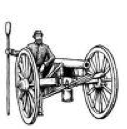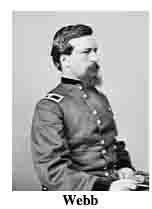
The 2nd Corps, 2nd Division, 2nd Brigade was also known as Webb’s Brigade. During the battle of Gettysburg, it served as a member of Gibbon’s Division in the Second Corps, Army of the Potomac. The brigade was commanded by Brigadier General Alexander Stewart Webb (February 15, 1835 – February 12, 1911), a career United States Army officer and a Union general in the American Civil War who won the Medal of Honor for gallantry at the Battle of Gettysburg. After the war, he was president of the City College of New York for thirty-three years. Webb died in Riverdale, New York. He is buried in West Point National Cemetery. A statue of Gen Webb was dedicated in the Gettysburg National Military Park in 1915.
The Webb's Brigade - US Brigade Tablet, also known as the Army of The Potomac 2 Corps 2 Division 2 Brigade Tablet, is located on Hancock Avenue, on the right or east side of the road of traveling north, just north of the Copse of Trees, site of the High Water Mark of the Rebellion. This area is an absolute beehive of activity as this site represents the best of what Gettysburg has to offer, both historically and monumentally.  Parking is plentiful and is available road-side at intermittently enlarged shoulder cut-outs, usually marked with white striping. Be sure to keep vehicles off the grass or you will be ticketed by park police. I visited this monument on Tuesday, August 7, 2012 at 4:47 PM. I was at an elevation of 619 feet, ASL. I used a Canon PowerShot 14.1 Megapixel, SX210 IS digital camera for the photos.
Parking is plentiful and is available road-side at intermittently enlarged shoulder cut-outs, usually marked with white striping. Be sure to keep vehicles off the grass or you will be ticketed by park police. I visited this monument on Tuesday, August 7, 2012 at 4:47 PM. I was at an elevation of 619 feet, ASL. I used a Canon PowerShot 14.1 Megapixel, SX210 IS digital camera for the photos.
The monument work was completed under the direction of the Gettysburg National Park Commission (established by the United States Department of War), after they took over the administration of the park from the Gettysburg Battlefield Memorial Association (whose funds had expired) on March 3, 1893, and whose stewardship was then transferred to the National Park Service in 1933) SOURCE. According to the NRHP narrative, this monument was built in 1911, which according to my experience is questionable. I can't resolve if the 1911 date represents a completion of the physical construction of the tablet or when it was started with an unknown installation date. Other sources have it at 1910 & 1912. I don't know if anyone actually kept exact records of when these things were installed.
Draw the Sword, with descriptive help from the NPS site, offers the following description: One of 74 (or 75 depending who you listen to) brigade monuments erected at Gettysburg by the War Department to describe the movements and itinerary of each Union brigade of the Army of the Potomac. The pedestals consist of sea-green granite with a square 36” x 36” base; they weigh 3500 pounds. On each pedestal is mounted a bronze tablet with rounded corners weighing 300 pounds. Bronze inscription tablet, 4”0’ x 3’8”, attached to slant face of polished sea green granite monolith. 3’0” squared base of monument tapers to a smaller dimension at the tablet. All 5’4” H. The monuments were designed by E.B. Cope. Many of the inscription tablets were made of bronze melted down from Civil War cannons. The trefoil of the Second Corps appears at the top of the tablet, just above the main inscription. The inscription on this tablet reads:
 Army of the Potomac
Army of the Potomac
Second Corps Second Division
Second Brigade
Brig. Gen. Alexander S. Webb
69th. 71st. 72d. 106th. Penna. Infantry.
July 2 The 69th Penna. took position along the advanced line of the stone wall at the left of the Angle. The other regiments of the Brigade in the rear of the ridge. During the day two companies of the 71st and two of the 106th Penna. were sharply engaged on the skirmish line. About sunset Brig. Gen. Wright's Brigade charged across the Emmitsburg Road to the Union line past the guns of Battery B 1st Rhode Island but was soon repulsed with the loss of many prisoners and forced back beyond the Emmitsburg Road. All the guns temporarily lost were retaken. At night the 71st and 106th Penna. except two companies on skirmish line were sent to the support of the Eleventh Corps on East Cemetery Hill. The former returned at midnight the later remained.
July 3 At 3 p.m. after heavy cannonading for two hours Major Gen. Pickett's Division of about 5,000 men charged the line held by this and the Third Brigade breaking through the line at the Angle. Reinforcements coming up quickly the charge was repulsed with great loss nearly 1,000 prisoners and six battle flags were reported captured by the Brigade.
Casualties. Killed 9 officers 105 men. Wounded 27 officers 311 men. Captured or missing 5 officers 34 men. Total 491.
There are hundreds of non-sculpted monumentation for the various Confederate States & Union units which fought at Gettysburg. There are about 10 different variations of tablets, markers & monoliths by my reckoning. Six designs represent brigade (2), division (2), corps (2), & army headquarters (2), each different in a subtle way so as to distinguish between armies. Battalion/battery/advance position markers & regimental monuments for U.S. Regulars & Confederate have their own distinct design (2), bringing the total to 10 designs at the battlefield. The bronze tablets were created by Albert Russell & Sons Co. of Newburyport, Mass. The granite bases which accompany the various tablets were created by the Van Amringe Company from Boston, Mass. The cast iron tablets were manufactured by Calvin Gilbert. The 1910 Gettysburg Commission report lists the awarded contracts to these companies (not Gilbert) for the tablets. All of these tablets were designed by architect Colonel Emmor Bradley Cope (July 23, 1834 - May 28, 1927). He designed pretty much every tablet for both the Union & Rebel armies, each one distinct, w/ several different varieties. He is buried in Evergreen Cemetery  in Gettysburg, as well he should be as this park and most of the things seen here today were designed by him and as such, are his legacy. These monuments were erected just after the turn of the century during the first & beginning of the second decade of the 20th century. Each one has since been preserved or restored at least twice since the turn of the 21st century. The plaques & tablets were erected by the Gettysburg Park Commission (established by the War Dept.). The Gettysburg Park Commission is also referred to as the Gettysburg National Military Park Commission or the Gettysburg National Park Commission, to clear up any confusions, especially my own.
in Gettysburg, as well he should be as this park and most of the things seen here today were designed by him and as such, are his legacy. These monuments were erected just after the turn of the century during the first & beginning of the second decade of the 20th century. Each one has since been preserved or restored at least twice since the turn of the 21st century. The plaques & tablets were erected by the Gettysburg Park Commission (established by the War Dept.). The Gettysburg Park Commission is also referred to as the Gettysburg National Military Park Commission or the Gettysburg National Park Commission, to clear up any confusions, especially my own.
On October 1, 1898, the Gettysburg National Park Commission in a letter to the Secretary of War set gave recommendations for continuing the task of organizing & progressing the work of the Gettysburg National Military Park. Every November they wrote their annual report which outlined the work of the GNPC for that year. The following is an excerpt from that report relevant to this waymark. The link at the end of the paragraph will take you to the entire report. The method of marking the positions of troops on this field, as approved by the War Department, is to place the principal tablet or monument of each command at the position occupied by the command in the main line of battle, and to mark the several important positions subsequently reached by each command in the course of the battle by subordinate and ancillary tablets, with appropriate brief inscriptions giving interesting details and occurrences and noting the day and hour as nearly as possible. SOURCE
Most of the Commission reports have been digitized and can be found HERE. The initial 1893 report up to & including 1921 can be found here. 1922 to 1926 are missing & have yet to be discovered. The years 1927 to 1933 were discovered in 1996 and are also included. To my knowledge this is the most comprehensive list of documents that illustrated the development and formation of the park.
Information about these specific types of monuments:
BRIGADE HEADQUARTERS MARKERS (FOR UNION & CONFEDERATE TABLETS)
Brigade Headquarters (and Confederate artillery battalions, equivalent to Union artillery brigades) are bronze tablets mounted at an angle on a stone pedestal. They are the most numerous headquarters at Gettysburg, with over 70 Union and over 60 Confederate examples on the field. Union headquarters are marked with their corps or service branch symbol (like a cross, clover or crescent moon), while Confederate headquarters are simply labeled "C.S.A.". There are seventy-four brigade markers at Gettysburg honoring the AOP’s various brigades. (Other sources say there are 75). They were built by Albert Russell & Sons Co. of Newburyport, Massachusetts and Charles Kappes. The pedestals consist of sea-green granite with a square 36” x 36” base; they weigh 3500 pounds. On each pedestal is mounted a bronze tablet with rounded corners weighing 300 pounds. There are sixty-four brigade markers honoring the Army of North Virginia's various brigades. They were built by Van Amringe Granite Company (pedestals), Albert Russell & Sons Co., Newburyport, Mass (tablets) and Charles Kappes (foundations). The last was completed in December 1910. The 1910 date is disputed by other sites listing the end dates as 1912. The monuments consist of red circular Maine granite bases 34 1/2 inches diameter and weighing 3,000 pounds. On each base is mounted a 300 pound bronze tablet. SOURCE & SOURCE
The Webb's Brigade - US Brigade Tablet is a contributing feature to the Gettysburg Nat'l Military Park H.D. which is nationally significant under NR Criteria A, B, C & D. Areas of Significance: Military, Politics/Gov't, Landscape Architecture, Conservation, Archeology-Historic. Period of Significance: 1863-1938. The monument is designated as structure no. MN475.
From the Nomination Form:
1 of 75 Civil War US Brigade Tablets in Park. Records movement & itinerary of Webb's 2nd Brigade during Battle of Gettysburg, July 1-3, 1863.h's 4th Volunteer Reserve Artillery Brigade during Battle of Gettysburg, July 1-3, 1863.
Short Physical Description:
Bronze inscription tablet, 4”0’ x 3’8”, attached to slant face of polished sea green granite monolith. 3’0” squared base of monument tapers to a smaller dimension at the tablet. All 5’4” H.
Long Physical Description:
Located E side of Hancock Ave across from the Copse of Trees.

My Sources
1. NRHP Nomination Form
2. Stone Sentinels
3. Virtual Gettysburg
4. Draw the Sword
5. Historical Marker Database